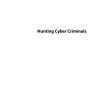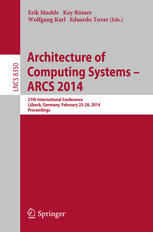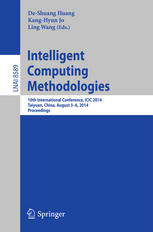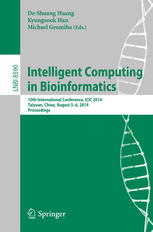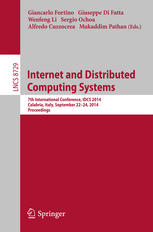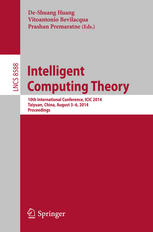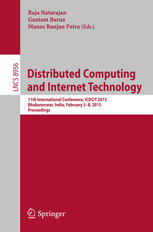Distributed Computing and Internet Technology 10th International Conference ICDCIT 2014 Bhubaneswar India February 6 9 2014 Proceedings 1st Edition by Raja Natarajan ISBN 3319044834 9783319044835
$50.00 Original price was: $50.00.$25.00Current price is: $25.00.
Distributed Computing and Internet Technology 10th International Conference ICDCIT 2014 Bhubaneswar India February 6 9 2014 Proceedings 1st Edition by Raja Natarajan – Ebook PDF Instant Download/Delivery: 3319044834, 9783319044835
Full download Distributed Computing and Internet Technology 10th International Conference ICDCIT 2014 Bhubaneswar India February 6 9 2014 Proceedings 1st Edition after payment
Product details:
ISBN 10: 3319044834
ISBN 13: 9783319044835
Author: Raja Natarajan
This book constitutes the refereed proceedings of the 10th International Conference on Distributed Computing and Internet Technology, ICDCIT 2014, held in Bhubaneswar, India, in February 2014. The 29 revised full papers presented together with 6 invited talks in this volume were carefully reviewed and selected from 197 submissions. The papers cover topics such as distributed computing, sensor networks, Internet technologies and applications, security and multimedia.
Distributed Computing and Internet Technology 10th International Conference ICDCIT 2014 Bhubaneswar India February 6 9 2014 Proceedings 1st Table of contents:
Section 1: Invited Talks
Hop and HipHop: Multitier Web Orchestration
1 Introduction
2 Hop
3 The HipHop Programming Language
3.1 HipHop Events
3.2 Reactive Machines and Their Reactions
3.3 HipHop Intuitive Execution Semantics
3.4 HipHop Core Statements
3.5 HipHop Derived Statements
4 An Application Example
4.1 HopFM Implementation
5 Related Work
6 Conclusion
References
Reinforcement Learning for Matrix Computations: PageRank as an Example
1 Introduction
2 The Algorithm
3 Remarks
4 NumericalExperiments
5 Conclusions
References
The New Normal?
1 Introduction
2 Internet Research Circa 2013: The New Normal?
3 Are We Our Data?
4 Concluding Remarks
References
Cyber Security via Signaling Games: Toward a Science of Cyber Security
1 Introduction
2 The Game Theoretic Models
3 The Results from Simulation
3.1 Behavior Modes (dependent on parameters d, e, f, g)
3.2 Strategies
3.3 Equilibrium Strategies at a Glance
3.4 Limiting Measures of Send Cooperate and Receive Cooperatively
4 Discussion
References
Privacy through Accountability: A Computer Science Perspective
1 Introduction
2 Contextual Integrity and Logic of Privacy
3 Policy Auditing over Incomplete Logs
4 Formalizing and Enforcing Purpose Restrictions
5 Audit Games
References
Cells as Machines: Towards Deciphering Biochemical Programs in the Cell
1 Introduction
2 Biochemical Reaction Systems
3 Symbolic Model-Checking of Biochemical Systems
4 Quantitative Temporal Logic Constraints
4.1 Threshold and Timing Constraints
4.2 Parameter Optimization
4.3 Robustness Measure
5 Biochemical Programming
6 Conclusion
References
Section 2: Distributed Computing
A Spatial Web Crawler for Discovering Geo-servers and Semantic Referencing with Spatial Features
1 Introduction
2 Proposed Framework: WFS Crawler
2.1 Crawler Architecture
2.2 Spatial Crawler Algorithm Description
3 Performance Evaluation
4 Conclusion
References
Software Transactional Memory Friendly Slot Schedulers
1 Introduction
2 Basics of Slot Scheduling
3 Parallel Slot Scheduling Using STMs
3.1 The SimpleScan Algorithm
3.2 The SoftV isible Algorithm
4 Evaluation
References
An Improved Approach of Decoupling in Mobile Cloud Computing
1 Introduction
2 Proposed Notion of Hierarchical Decoupling in MCC
2.1 Hierarchical Decoupling
2.2 Proposed Mobile Cloud Architecture
3 Conclusion
References
Value Added Services on Stationary Vehicular Cloud
1 Introduction
2 Related Work
3 Communication in SVC
3.1 Association
3.2 Services
3.3 Disassociation
4 Performance Analysis
5 Conclusion
References
FTM2: Fault Tolerant Batch Mode Heuristics in Computational Grid
1 Introduction
2 Related Work
3 Preliminaries
3.1 Problem Definition
3.2 Scheduling Algorithms
4 Proposed Heuristic
4.1 Description
4.2 Heuristics
5 Experimental Study
6 Conclusion
References
SNAPWebD and SNAPSync: A Web Desktop and Transparent sync of NFS and Standalone System Logical Volum
1 Introduction
2 SNAPWebD
3 SNAPSync
4 Conclusions and Future Work
References
Section 3: Sensor Networks
Energy-Aware Multi-level Routing Algorithm for Two-Tier Wireless Sensor Networks
1 Introduction
2 Related Work
3 System Model
3.1 Network Model
3.2 Energy Model
4 Proposed Algorithm
4.1 Backbone Network (BN) Formation
4.2 Routing
5 Simulation Results
5.1 Network Lifetime
5.2 Energy Consumption
6 Conclusion
References
Minimum Range Assignment Problem for Two Connectivity in Wireless Sensor Networks
1 Introduction
2 Related Work
3 NP-Hardness of MP2CS
4 MST-Augmentation Algorithm for MP2CS
5 Proposed Heuristic for MP2CS Problem
6 Experimental Results
7 Minimum Power k Backbone 2 Connected Subgraph
7.1 MPkB2CS Problem for k = 2
7.2 MPkB2CS Problem for k = 3
7.3 MPkB2CS Problem for k > 3
8 Conclusion
References
A Digital-Geometric Approach for Computing Area Coverage in Wireless Sensor Networks
1 Introduction
2 Preliminaries
3 Intersection of Two Digital Circles
3.1 Point Containment
3.2 Run Position of a Circumference Point
3.3 Intersection Points
3.4 Algorithm for Finding Intersection Points
4 Area Coverage by a Set of Digital Circles
4.1 Intersection of a Set of Monotone Objects
4.2 Area Computation
4.3 Centralized Algorithm for Area Coverage
4.4 Distributed Algorithm for Area Coverage
5 Simulation Results
6 Conclusion
References
Effect of Choice of Discretization Methods on Context Extraction from Sensor Data – An Empirical E
1 Introduction
2 Wireless Sensor Data – Discretization and Context Extraction
3 Experiments and Evaluation
3.1 Evaluation Metrics and Methods
3.2 Results
4 Conclusions
References
Section 4: Internet Technologies and Applications
Discrete Krill Herd Algorithm – A Bio-Inspired Meta-Heuristics for Graph Based Network Route Optim
1 Introduction
2 Krill Herd Algorithm and Mathematics
2.1 Concentration Enhancement Movement
2.2 Phototatic Swarming Movement
2.3 Random Movement
2.4 Reproduction and Genetic Crossover
2.5 Predator’s Prey
2.6 Predator’s Rush
2.7 Moulting
3 Discrete Krill Herd Algorithm
4 Methods and Algorithms
4.1 Discrete KHA forOptimized Route Search
5 Computational Results and Graphs
6 Conclusion and Future Works
References
A New Number System Using Alternate Fibonacci Numbers as the Positional Weights with Some Engineerin
1 Introduction
2 Preliminaries
3 Proposed Tri-digit Fibonaccian Number System
4 Deriving TFNS Digit Distributions
4.1 Computation of vo
4.2 Computation of ν1 and ν2
5 Conclusion
References
User Profiling Based on Keyword Clusters for Improved Recommendations
1 Introduction
2 Literature Review
2.1 Collaborative Filtering and Content-Based Filtering
2.2 Content-Based User Profiles
3 Proposed User/Item Profiles Using Keyword Clusters
4 Experimental Evaluation
4.1 Effect of Initial Cluster Size
4.2 Effect of Sparsity
5 Conclusions
References
Equilibrium Balking Strategy in an Unobservable GI/M/c Queue with Customers’ Impatience
1 Introduction
2 Description and Analysis of the Model
2.1 System-Length Distribution at Pre-arrival Epoch
2.2 System-Length Distribution at Arbitrary Epoch
3 Performance Measures
3.1 Mean System-Length and Sojourn Time Analysis
3.2 An Equilibrium Balking Strategy for Unobservable Queue
4 Numerical Results
5 Conclusion
References
Energy-Aware H.264 Decoding
1 Introduction
2 Background
2.1 H.264 Standard
2.2 Measurement of Energy Consumption
2.3 Measures of Video Quality
3 Methodology
3.1 Calibration of Power Model
3.2 Profiling of Video Decoder
3.3 Modification of Video Decoder
4 Experiment and Results
5 Related Work
6 Conclusion
References
A Cost Effective Approach for Analyzing Software Product Lines
1 Introduction
2 Model of SPL : Traceability and Cost Relation
3 Analysis Operations
4 Validation
4.1 SPLANE-CF
4.2 QSAT Performance
5 Conclusion
References
Fuzzy Logic Based Similarity Measure for Information Retrieval System Performance Improvement
1 Introduction
2 Proposed Fuzzy Logic Based Similarity Measure
3 Evaluation of Performance of Information Retrieval System
4 Experiments and Results
4.1 Precision-Recall Curve
4.2 Average Similarity Value
4.3 Average Number of Retrieved Relevant Documents
5 Conclusion
References
Maximizing Information or Influence Spread Using Flow Authority Model in Social Networks
1 Introduction
2 Related Work
2.1 RankReplace Algorithm and Its Drawback
2.2 Degree Discount Heuristics
3 Proposed Algorithm
3.1 Willingness to Send Heuristic
3.2 Algorithm Using Willingness to Send Heuristic
4 Experimentation on Data Set
4.1 Results
5 Conclusion
References
Section 5: Security
A Second View on SecureString 2.0
1 Introduction
2 En- and Decryption Scheme
3 Character String Functions
3.1 Querying
3.2 Replacing
3.3 Picking
4 Threat Model
4.1 n-gram Repetition Pattern Attack
4.2 n-gram Distribution Attack
5 Performance
5.1 Querying Performance
5.2 Replacing Performance
5.3 Picking Performance
6 Conclusion
References
Friend or Foe: Twitter Users under Magnification
1 Introduction
2 Related Work
3 Data Characteristics
4 Investigating User Activity
5 Tagging Suspicious Users
6 Results
7 Discussion and Conclusion
8 Future Scope
References
Game Theoretic Attack Response Framework for Enterprise Networks
1 Introduction
2 Preliminaries and Related Works
3 Stochastic Game Based IR Model
3.1 Construction of Stochastic Game – Given a Network Configuration
3.2 Decision on Administrator’s Optimal Action Using Nash Equilibrium
4 Case Study
4.1 Stochastic-Game Construction for Test-Network
4.2 Decision Making Using Nash Equilibrium
5 Experimental Results
6 Conclusion
References
Dynamic Ciphertext-Policy Attribute-Based Encryption for Expressive Access Policy
1 Introduction
2 Background
2.1 Access Policy Tree
2.2 A CP-ABE Template
3 Proposed CP-ABE Construction
4 Security Analysis
5 Performance
6 Conclusion
References
Improvisation of Biometrics Authentication and Indentification through Keystrokes Pattern Analysis
1 Introduction
2 Motivation
3 Related Work
4 Proposed Methodology
4.1 Capturing Keystroke Features
4.2 Calculation of Degree of Disorder
4.3 Calculation of Standard Deviation
4.4 User Profile Generation
4.5 Identification and Authentication
5 Simulation and Analysis of Result
6 Conclusion and Future Works
References
Enhancing Privacy in Online Social Communities: Can Trust Help Mitigate Privacy Risks?
1 Introduction
2 Background
3 Simulation
3.1 Experimental Setup
3.2 Simulation Results
4 Discussion
5 Conclusion
References
Section 6: Multimedia
Detection and Reduction of Impulse Noise in RGB Color Image Using Fuzzy Technique
1 Introduction
2 Background
2.1 Color Model
2.2 Impulse Noise
2.3 Fuzzy Logic
3 Detection of Impulse Noise in RGB Color Image
3.1 Calculation of Absolute Value Differences
3.2 Computing Membership Degree
3.3 Degree of Similarity Calculation
3.4 Degree of Similarities among Different Color Components of Same Pixel
3.5 Calculating Noise Free Degree
4 De-noising Method
5 Experimental Results and Analysis
6 Motivation
7 Conclusion
References
An Efficient Method for Speckle Reduction in Ultrasound Liver Images for e-Health Applications
1 Introduction
1.1 Speckle Reduction
2 Related Works in Speckle Reduction
3 Proposed Modified Laplacian Pyramid Nonlinear Diffusion for e-Health Applications
3.1 Laplacian Pyramid Domain
3.2 Nonlinear Diffusion
3.3 Modified Diffusivity Function
3.4 Gaussian Filter
3.5 Median Absolute Deviation (MAD) Estimator
4 Experimental Results
4.1 Liver Dataset
4.2 Performance Metrics
4.3 Discussion
5 Conclusion
References
Comparative Improvement of Image Segmentation Performance with Graph Based Method over Watershed Tra
1 Introduction and Related Work
2 Watershed Transform Image Segmentation
3 Graph Based Image Segmentation
3.1 Algorithm : Segmentation algorithm.
4 Analysis of Watershed Image Segmentation and Graph Based Image Segmentation
5 Implementation and Results
6 Conclusion
References
Modeling Diffusion of Tabletop for Collaborative Learning Using Interactive Science Lab Simulations
1 Introduction
2 Case Study: Factors Affecting Diffusion of Tabletop Technologies for Collaborative Learning
2.1 Research Model and Hypothesis
3 Research Methodology
3.1 Experimental Design
4 Results Analysis and Discussion
4.1 Quantitative Analysis
4.2 Tabletop vs. Desktop
4.3 Video Analysis of EG1
4.4 Performance Gain between Pre and Post Tests
4.5 Regression Model for Collaborative Learning Using Tabletops
5 Conclusions
References
A Binarization Feature Extraction Approach to OCR: MLP vs. RBF
1 Introduction
2 Feature Extraction Using Binarization Technique
3 Sample Preparation
4 Implementation and Discussion of Results
5 Conclusion and Future Scope
People also search for Distributed Computing and Internet Technology 10th International Conference ICDCIT 2014 Bhubaneswar India February 6 9 2014 Proceedings 1st:
distributed computing and internet technology
international conference on distributed computing and internet technology
what is distributed computing with example
what is distributed computing
what does distributed computing mean
Tags:
Raja Natarajan,Distributed Computing,Internet Technology,International Conference,ICDCIT,Bhubaneswar India
You may also like…
Computers - Networking
Computers - Computer Science
Computers - Computer Science
Computers - Computer Science
Computers - Networking
Computers - Computer Science
Computers - Networking




